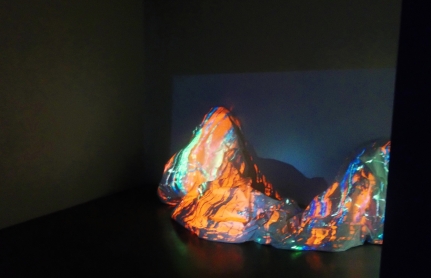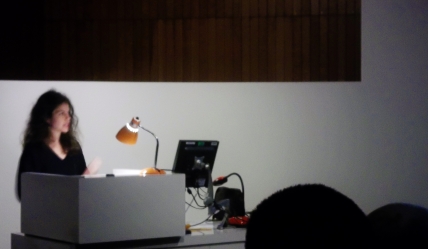

During my time in Intro to Media Arts, I was required to complete what is called “Professional Practices”. To anyone who doesn’t know what that is, “Professional Practices” required the student to conduct an interview or attend an art exhibit/lecture and then write a 500 page paper on the experience. In order to fulfill the requirement, I attended the Krause Gallery Exhibit titled After Glow located at the University of Oregon (UO). The exhibit, an experiment with glowing objects and darkness, consisted mainly of everyday objects painted or dyed in colors that would glow in the dark. One of these displays, which is shown in picture #1, resembled a large piece of cloth with splotches of glow-in-the-dark tie dye and draped over some mound. Another display featured a sort of stone pillar with a plastic or glass square, topped with a bowl of what I assume was aquarium pebbles. Upon closer examination of the plastic or glass square, I realized that this was actually an ingenious display within a display that showed a video of someone manipulating glowing sand in darkness. As the person’s hands moved quickly and fluidly, arranging the sand into weird shapes, I was taken aback on how mesmerizing this video was, and it proved to be the highlight of the exhibit. For the most part, however, the exhibit was thoroughly disappointing and didn’t seem to warrant an entire exhibit on it. The reception was very well put together with food and drinks set up outside the exhibit where people conversed with each 0ther until it was time for the next event of the night.
Later we all crowded into a separate building for a lecture by well known and celebrated curator Ruba Katrib on Sculpture as Substance. To anyone who has not heard of Miss Katrib, she is the curator for SculptureCenter in Long Island City, New York, producing group shows such as The Eccentrics (2015), Puddle, Pothole, Portal (2014) (which she co-curated with artist Camille Henrot), Better Homes (2013) and A Disagreeable Object (2012). Before the main lecture commenced several other people took the stand in order to address the event and to introduce its main speaker. The first person talked about the founding of the Connective Conversations which this was a part of, and how it helped artists from around the state of Oregon to participate. The second speaker listed Katrib’s exploits and introduced her to the audience, which was met with a round of applause. When Miss Katrib finally took the stand, she proceeded to talk about the fundamentals of sculpture and how the art of sculpture engages our sensory realms. An example she gave of this was the work of artist Anicka Yi, and one of here design’s with clothing and Tempuru-fried flowers engaged the viewer’s sense of smell and taste. Katrib also pointed out that art can mimic or suggest real life or the human body, such as Marcel Dechamp’s Wedge of Chastity and the Skin Pool, the latter of which represented art in an organic form. There was so many other fascinating concepts that Miss Katrib talked about, all of which were eye-opening to me as an artist. Particularly the concept of art engaging one’s sensory realms was something that I never heard before and it proved to be a very educational experience which I hope to use this knowledge in my field in order to improve upon my skills as an artist.
